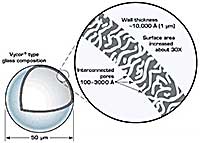Jun 11 2008
What looks like a fertilized egg, flows like water, gets
stuffed with catalysts and exotic nanostructures and may have the
potential of making the current retail gasoline infrastructure
compatible with hydrogen-based vehicles of the future – not
to mention also contributing to arenas such as nuclear proliferation
and global warming?
 Schematic representation of microsphere wall porosity. Credit: Savannah River National Lab, American Ceramics Society
Schematic representation of microsphere wall porosity. Credit: Savannah River National Lab, American Ceramics Society
The answer is contained in the June issue of The Bulletin, the
monthly magazine of The American Ceramic Society,
which carries the first news of a never-before-seen class of materials
and technology developed by scientists at the Savannah River National
Laboratory.
This unique material, dubbed Porous Wall-Hollow Glass
Microspheres (PW-HGM), consists of porous glass 'microballoons' that
are smaller than the diameter of a human hair. The key characteristic
of these 2-100 micron spheres is an interconnected porosity in their
thin outer walls that can be produced and varied on a scale of 100 to
3,000 Angstroms.
SRNL Researchers G.G. Wicks, L.K. Heung, and R.F. Schumacher
have been able to use these open channels to fill the microballons with
gas absorbents and other materials. Hydrogen or other reactive gases
can then enter the microspheres through the pores, creating a
relatively safe, contained, solid-state storage system.
Photographs of these glass-absorbent composites also reveal
that the wall porosity generates entirely new nano-structures.
Wicks, Heung and Schumacher have shown that the PW-HGM's
permeable walls can be used for non-composite purposes, too. For
example, the porosity can be altered and controlled in various ways
that allow the spheres to filter mixed gas streams within a system.
Another feature of the microballoons is that their mechanical
properties can be altered so they can be made to flow like a liquid.
This suggests that an existing infrastructure that currently
transports, stores and distributes liquids such as the existing
gasoline distribution and retail network can be used. This property and
their relative strength also make the PW-HGMs suitable for reuse and
recycling.
The SRNL team is involved in more than a half dozen programs
and collaborations involving the PW-HGMs in areas such as hydrogen
storage in vehicles (Toyota), gas purification and separations, and
even very diverse applications including abatement of global warming
effects, improving lead-acid battery performance and nuclear
non-proliferation. Applications such as the development of new drug
delivery systems and MRI contrast agents are also blossoming in the
medical field (Medical College of Georgia).